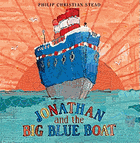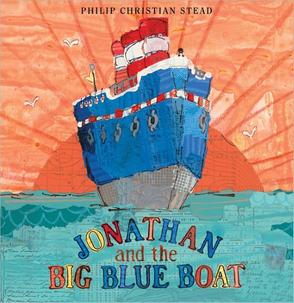
 Philip Christian Stead (Creamed
Tuna Fish and Peas on Toast; A Sick
Day for Amos McGee) firmly establishes the affection that the hero,
Jonathan, has for his bear, Frederick, in the first few pages. The soulful
stuffed animal leans against a jetty post as the sun sets and a buoy bobs in
the aqua harbor, reflecting the sun's rays, beneath the dedication: "To
Frederick." At the story's opening, Jonathan holds Frederick "up high
so he could see the Big Blue Boat too," anchored in the harbor. "It
makes me feel very small," Jonathan tells Frederick. Still, we get the
sense that the bear makes the boy feel brave. The giant vessel pulses in a
swirl of sapphire and cornflower blues comprised of torn paper and postage
stamps. A candy-cane stripe wraps around its upper quarters, with
peppermint-candy lifesavers hanging off the top deck. On the next spread,
Jonathan's parents inform him they have traded Frederick for a toaster. "You're
getting too old for a stuffed animal," they say. "Toasters really are
useful."
Philip Christian Stead (Creamed
Tuna Fish and Peas on Toast; A Sick
Day for Amos McGee) firmly establishes the affection that the hero,
Jonathan, has for his bear, Frederick, in the first few pages. The soulful
stuffed animal leans against a jetty post as the sun sets and a buoy bobs in
the aqua harbor, reflecting the sun's rays, beneath the dedication: "To
Frederick." At the story's opening, Jonathan holds Frederick "up high
so he could see the Big Blue Boat too," anchored in the harbor. "It
makes me feel very small," Jonathan tells Frederick. Still, we get the
sense that the bear makes the boy feel brave. The giant vessel pulses in a
swirl of sapphire and cornflower blues comprised of torn paper and postage
stamps. A candy-cane stripe wraps around its upper quarters, with
peppermint-candy lifesavers hanging off the top deck. On the next spread,
Jonathan's parents inform him they have traded Frederick for a toaster. "You're
getting too old for a stuffed animal," they say. "Toasters really are
useful."
Jonathan brings to mind Ezra Jack Keats's Peter when his baby sister comes along to claim Peter's chair and crib, and out on a solo adventure on a snowy day. As Jonathan starts his search for his bear, Stead's urban setting, like Keats's, feels both welcoming and daunting. The red-and-white smokestacks of the Big Blue Boat tower over the rooftops near the hero's apartment building, and we know where he is bound. Jonathan's singleness of purpose guides each of his encounters and points the way to the next phase of his journey. When the tugboat captain asks Jonathan, "Why so sad?" and the boy explains, "Frederick is missing," the captain starts him on his way, tugging the Big Blue Boat "into the open ocean." Thus begins the cumulative refrain: "And that is how Jonathan came to sail the sea on a Big Blue Boat." When the boat gets marooned, a mountain goat helps, so Jonathan invites him along. Sepia-toned vignettes move the action ahead, while the full-color compositions focus on the emotional interplay between Jonathan and the goat. They encounter a circus elephant (who might have stepped out of Amos McGee), and a brush with pirates necessitates the aid of a whale ("And that is how Jonathan, a mountain goat, and a circus elephant came to sail the sea on a Big Blue Boat on the back of a whale"). The title boat never looks the same in any two pictures, contributing to the sense of the Big Blue Boat as a major player in the story. One of the most remarkable images occurs at night as the elephant and goat "snored like a foghorn and a whistle." The stars shine brightly in a midnight-blue sky, distinct from blue-painted collage papers of longitude and latitude that fill the sea, where the Big Blue Boat rests serenely on the whale's back. A sepia-toned vignette of a lighthouse on the page opposite "show[s] the way to a distant port," and we feel certain that all will be well.
Stead combines playful compositions and his hero's serious intent in a winning combination. What at first seems almost whimsical, upon closer inspection reveals careful planning in each illustration. Even though the tugboat captain's coat is a patchwork of printed papers and wax stripes, he appears distinguished. Why do the polka dots on the elephant add to rather than detract from his complex character? Stead seems to tell us that as long as we follow our true North, everything falls in line. Jonathan reminds children that our Fredericks don't hold us back, they help us grow up with confidence. And there's no rush.--Jennifer M. Brown

